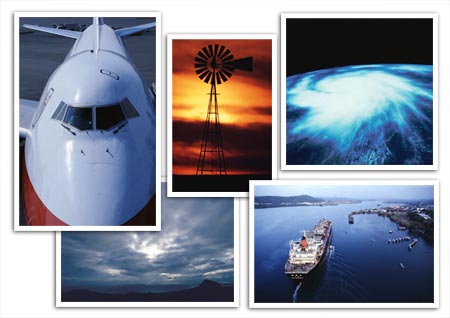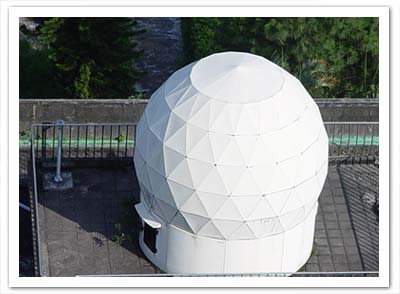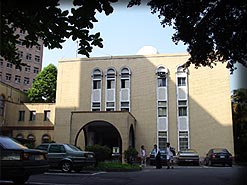Super User
Graduate Selective
| Master Program(M-head) | |||
| Course | Instructor | credits | Content(to be updated) |
| Advanced Atmospheric Dynamics | CHUNG-HSIUNG SUI / HUNG-CHI KUO |
3 | |
| Advanced Synoptic Meteorology | TAI-JEN GEORGE CHEN / CHENG-SHANG LEE |
3 | |
| Mesoscale Meteorology | CHENG-KU YU / BEN JONG-DAO JOU |
3 | |
| Advanced Numerical Prediction | WEN-SHUNG KAU | 3 | |
| Applied Statistics in Meteorology(I)(II) | MING-CHIN WU | 3 | |
| Geophysical Fluid Dynamics | HUNG-CHI KUO | 3 | |
| Atmospheric Boundary Layer Modeling | CHING-CHI WU | 2 | |
| Quasi-balanced Dynamical System in the Atmosphere | CHUN-CHIEH WU | 3 | |
| Air-Sea Interaction and its Numerical Simulation | YU-HENG TSENG | 3 | |
| Tropical Cyclone Dynamics | CHUN-CHIEH WU | 3 | |
| Doctor Program(D-head) | |||
| Course | Instructor | credits | Content |
Undergraduate Selective
| Undergraduate Selective | |||
| Course | Instructor | credits | Content |
| Atmospheric Chemistry | GLORIA KUANG-JUNG HSU | 3 | |
| Radar Meteorology | BEN JONG DAO JOU | 3 | |
| Boundary Layer Meteorology | CHING-CHI WU | 3 | |
| Numerical Weather Prediction | MING-JEN YANG | 3 | |
| Atmospheric Remote Sensing | I-I LIN | 3 | |
| Climate Diagnostics | HUANG-HSIUNG HSU | 2 | |
| Field Measurement of Atmospheric Environment | PO-HSIUNG LIN | 2 | |
| Atmospheric Chemistry Experiments | SHAW-CHEN LIU / SHIH-CHUN LUNG / CHARLES C.-K. CHOU |
2 | |
| Data Integration and Analysis | PO-HSIUNG LIN | 3 | |
| An Introductory Survey to Atmospheric Science Research | each faculty | 2 | |
| Atmospheric Physical Chemistry | JEN-PING CHEN | 2 | |
| Global Atmospheric Circulation | YEN-TING HWANG | 3 | |
| Measurement of Atmospheric Environment | PO-HSIUNG LIN | 3 | |
| Choices and Analyses of Environmental Policy | GLORIA KUANG-JUNG HSU | 3 | |
| Earth System Model | BEN-JEI TSUANG / CHIEN-MING WU / MIN-HUI LO |
3 | |
| Weather Forecast-theory & Application | DER-YUAN WU | 3 | |
| Severe Weather Analysis and Forcasting | BEN JONG-DAO JOU | 2 | |
| Terrestrial and Global Hydrological Cycle | MIN-HUI LO | 2 | |
| Independent Study | each faculty | 2 | |
| Thesis (b.a.) | each faculty | 2 | |
Undergraduate Required
|
||||||||||||||||||||||||||||||||||||||||||||||||||||||||||||||||||||||||||||||||||||||||||||||||||||
Placements of Graduates

Our department provides a free learning environment and encourages students to be exposed to various fields. We expect that they acquire diverse abilities in all aspects. Consequently, the graduates have extensive job opportunities, including the following:
Meteorology-related agencies:Central Weather Bureau, Domestic/Overseas academic and research institutes of Atmospheric Sciences and Earth Sciences, Civil Aeronautics Administration, Military weather offices, and Weather forecasting and crews in television stations.
(Meteorology) Information integration:Computer information companies.
Environment-related field:Environmental Protection Administration and private consulting firms.
Earth science education:Earth Science teachers in high schools.
Others:public corporations, for example Taiwan Power Company; airway corporations; and private companies.
Education Objectives
 Atmospheric Science is a science which combines theory and application. Our department courses emphasize basic training in physics, mathematics, and computer science, as well as application of knowledge into the real world atmospheric problems. The courses can be divided into five categories: meteorology and dynamics, climatology, atmospheric environment, atmospheric observation, and earth science education. Because of the flexible courses, students are encouraged to explore the different categories according to their interests. Also, they are allowed to take other programs, including teacher education programs and earth science programs, as well as choose a minor or a double major. The minimum credits required by the department are 128 credits, including 18 credits of general requirements, 12 credits of general education, 66 credits of department requirements, 9 credits of department electives, and 23 credits of other electives. These regulations enable students to fully develop their potential and acquire diverse abilities.
Atmospheric Science is a science which combines theory and application. Our department courses emphasize basic training in physics, mathematics, and computer science, as well as application of knowledge into the real world atmospheric problems. The courses can be divided into five categories: meteorology and dynamics, climatology, atmospheric environment, atmospheric observation, and earth science education. Because of the flexible courses, students are encouraged to explore the different categories according to their interests. Also, they are allowed to take other programs, including teacher education programs and earth science programs, as well as choose a minor or a double major. The minimum credits required by the department are 128 credits, including 18 credits of general requirements, 12 credits of general education, 66 credits of department requirements, 9 credits of department electives, and 23 credits of other electives. These regulations enable students to fully develop their potential and acquire diverse abilities.
We are dedicated to cultivate Atmospheric Science talents and emphasize development in related fields including Earth Science and Computer Information, our department is top notch of local atmospheric research institutes. Some graduates pursue advanced studies, some work in meteorology-related agencies, such as the Central Weather Bureau and the Civil Aeronautics Administration. Other graduates work in meteorology, information, or environment related consulting firms. They make use of what they have learned. In response to the global trend of science integration, our ultimate goal is to teach our students a prospect of the world. In addition to acquiring professional knowledge in Atmospheric Science, we expect that they will achieve a deep insight in the environment and the Earth system as a whole, and contribute to the advancement of the brave new world.
History
 The department originated in December 1946 as the "Meteorological Research Center" of the Department of Agronomy, College of Agriculture. When the Department of Geography of the College of Sciences was established in August, 1955, there were two sections in the department: a Geography Section and a Meteorology Section. Under the effort of the former chairman Prof. Yu-chin Kang, the Meteorology Section became an independent department in July, 1972, and it was named the Department of Atmospheric Sciences.Two influences evolved from having independent departments: first, the students of our department increased from less than ten to 30~40. They became a new work force for the development of atmospheric sciences. Second, several years before and after the establishment, many scholars who received complete training of modern atmospheric sciences came back to teach one after another. The research and teaching of the Department of Atmospheric Sciences have expanded from traditional Meteorology to Synoptic Meteorology, Atmospheric Dynamics, Numerical Weather Prediction, and Air Pollution. The fields of the atmospheric sciences have broadened, and the modernization of domestic atmospheric science studies have been indirectly stimulated.
The department originated in December 1946 as the "Meteorological Research Center" of the Department of Agronomy, College of Agriculture. When the Department of Geography of the College of Sciences was established in August, 1955, there were two sections in the department: a Geography Section and a Meteorology Section. Under the effort of the former chairman Prof. Yu-chin Kang, the Meteorology Section became an independent department in July, 1972, and it was named the Department of Atmospheric Sciences.Two influences evolved from having independent departments: first, the students of our department increased from less than ten to 30~40. They became a new work force for the development of atmospheric sciences. Second, several years before and after the establishment, many scholars who received complete training of modern atmospheric sciences came back to teach one after another. The research and teaching of the Department of Atmospheric Sciences have expanded from traditional Meteorology to Synoptic Meteorology, Atmospheric Dynamics, Numerical Weather Prediction, and Air Pollution. The fields of the atmospheric sciences have broadened, and the modernization of domestic atmospheric science studies have been indirectly stimulated.
Ten years after being established, the department was in a stage of slow growth. There were no significant changes in the faculty. Not until the graduate school of Atmospheric Sciences was established in 1982, did the number of faculty members increase and the department step into a rapid expansion stage again. In the 1980s, due to quick economic growth in Taiwan, the environment for teaching and research has improved. Also, the Central Weather Bureau has stepped in to a modernized and computerized stage. Meanwhile, the influence of our teachers on domestic atmospheric sciences has been more and more significant. For instance, several professors headed by Ching-yen Tsay dedicated themselves to developing a numerical weather prediction system with the Central Weather Bureau and participated in domestic weather prediction modernization. In 1987, lead by Prof. George Tai-jen Chen, all faculty and meteorological administrators conducted a Taiwan Area Mesoscale Experiment (TAMEX), which was designed for mesoscale meteorology of heavy rain.The graduate program offering PhD degrees was set up in July, 1987. Our department can offer complete training from the Bachelors to the PhD level. Since the studies in the atmospheric environment field have been increasingly emphasized, our department divided the graduate program in M.S. degrees into two groups. Group A majored in Atmospheric Sciences, and Group B majored in Atmospheric Environment. The establishment of Group B not only enhanced the studies in the atmospheric environment field but also offered another channel for non-major undergraduates pursuing advanced studies. From 2002, Group A has been available for graduates majoring in the Atmospheric Sciences related field while Group B is for non-majors. Thus, talent from different backgrounds can be recruited. Recently, teaching and research in both software and hardware have been improved. Endeavoring to cultivate talents in atmospheric sciences, our department has 18 full-time teachers (including 2 jointly appointed teachers), 20 students in the PhD program, 83 students in the Masters program (40 in Group A and 53 in Group B), and 140 students in the Undergraduate program.
| Years | Events |
| 1946 | The Meteorological Research Center of the Department of Agronomy was established |
| 1955 | The Department of Geography of the College of Science was establishedTwo sections in the department: a Geography Section and a Meteorology Section. |
| 1972 | Independent department named the Department of Atmospheric Sciences |
| 1982 | MS program was established |
| 1987 | PhD program was established |
| 1989 | The Graduate program divided into two groups: Group A (majoring in Atmospheric Sciences) and Group B (majoring in Atmospheric Environment). |
| 2002 | The groups in the Graduate program changed to Group A (available for Atmospheric Sciences majors) and Group B (available for non-majors) |
| 1 | 2 | 3 | 4 | 5 | |
| Former Chairmen | Yu-chin Kang | Ken-chung Chou | Ching-yen Tsay | George Tai-jen Chen | Lin Ho |
| Tenures | 1972~1976 | 1977~1981 | 1982~1988 | 1989~1991 | 1992~1993 |
| 6 | 7 | 8 | 9 | 10 | |
| Former Chairmen | Wen-shung Kau | Cheng-shang Lee | Ben Jong-Dao Jou | Huang-Hsiung Hsu | JEN-PING CHEN |
| Tenures | 1994~1995 | 1996~1998 | 1999~2001 | 2002~2004 | 2005~2007 |
| 11 | 12 | ||||
| Former Chairmen | CHUN-CHIEH WU | I-I LIN | |||
| Tenures | 2008~2013 | 2014~ |
Location
 The Department of Atmospheric Sciences is located across from the College of Management, next to Choushan Road, on the main campus of National Taiwan University (NTU). Our unique landscape includes elegant architecture, a quiet environment, a spacious sight, a gigantic red and white observation tower, lush and spacious observing enclosure , and a spectacular spherical rawinsonde antenna.
The Department of Atmospheric Sciences is located across from the College of Management, next to Choushan Road, on the main campus of National Taiwan University (NTU). Our unique landscape includes elegant architecture, a quiet environment, a spacious sight, a gigantic red and white observation tower, lush and spacious observing enclosure , and a spectacular spherical rawinsonde antenna.
The Department is composed of three buildings. Having built in the age of Japanese colonialism, the "A block" possesses a historical air, and now contains most of the laboratories. "B block" was built in 1975, and now contains laboratories for teachers and classrooms. "C block" used to be the second and the third floors of the Atomic Energy Council. The library and computer labs are on the second floor, while the association office and the laboratories and classrooms for the graduates are on the third floor. Study rooms and group discussion rooms are also available so that the students have an environment for studying after class. Our department has a favorite pass-time: basketball. Thanks to the small basketball court, faculty and students can gather for casual pick-up games. In all, the lovely landscape, the state-of-the-art facilities, and the companionship between teachers and students bring together an excellent environment for learning!
教授研究精華
|
教師 |
2020-2021年間代表性著作 |
|
|
吳俊傑 |
Cheng, C.-J., and C.-C. Wu*, 2020: The role of WISHE in the rapid intensification of tropical cyclones. J. Atmos. Sci., 77, 3139-3160. https://doi.org/10.1175/JAS-D-20-0006.1 |
|
|
郭鴻基 |
Tsujino, S. and H.-C. Kuo*, 2020: Potential Vorticity Mixing and Rapid Intensification in Numerically Simulated Supertyphoon Haiyan (2013). J. Atmos. Sci., 77(6), 2067-2090. https://doi.org/10.1175/JAS-D-19-0219.1 |
|
|
林依依 |
Lin, I.-I.*, Rogers, R. F., Huang, H., Liao, Y., Herndon, D., Yu, J., Chang, Y., Zhang, J. A., Patricola, C. M., Pun, I., & Lien, C., 2021: A Tale of Two Rapidly Intensifying Supertyphoons: Hagibis (2019) and Haiyan (2013). Bulletin of the American Meteorological Society , 102.9, E1645-E1664, https://doi.org/10.1175/BAMS-D-20-0223.1 |
|
|
楊明仁 |
Miao, J.-E., and M.-J. Yang*, 2020: A modeling study of the severe afternoon thunderstorm event at Taipei on 14 June 2015: The roles of sea breeze, microphysics, and terrain. J. Meteor. Soc. Japan, 98, 129–152, doi: 10.2151/jmsj.2020-008 |
|
|
隋中興 |
Sui, C.-H., M. Satoh, and K. Suzuki, 2020: Precipitation efficiency and its role in cloud-radiative feedbacks to climate variability. J. Meteor. Soc. Japan, 98, 261–282, doi:10.2151/jmsj.2020-024. |
|
|
陳維婷 |
Chang, Y.-H., W.-T. Chen*, C.-M. Wu, C. Moseley, and C.-C. Wu (2021), Tracking the influence of cloud condensation nuclei on summer diurnal precipitating systems over complex topography in Taiwan, Atmos. Chem. Phys., 21, 16709–16725, https://doi.org/10.5194/acp-21-16709-2021 |
|
|
陳正平 |
T.-C. Tsai, J.-P. Chen*, 2020: Multi-moment ice bulk microphysics scheme with consideration for particle shape and apparent density. Part I: Methodology and idealized simulation. J. Atmos. Sci., 77, 5, 1821-1850. https://doi.org/10.1175/JAS-D-19-0125.1 |
|
|
林博雄 |
Hwang, W.-C., Lin, P.-H.*, and Yu, H., 2020: The development of the “Storm Tracker” and its applications for atmospheric high-resolution upper-air observations, Atmos. Meas. Tech., 13, 5395–5406, https://doi.org/10.5194/amt-13-5395-2020. |
|
|
盧孟明 |
Lu, M.-M.*, C.-H. Sui, C.-H. Wu, A. L. S. Solis, and M.-D. Cheng, 2021: Tropical cyclone climatology and variability in Taiwan and Philippine Region during 1979 - 2018. Terr. Atmos. Ocean. Sci., 32, 725-740, doi: 10.3319/TAO.2020.11.30.01 |
|
|
曾開治 |
Tseng, K.-C.*, Johnson, N. C., Kapnick, S. B., Delworth, T. L., Lu, F., Cooke, W., et al. (2021). Are multiseasonal forecasts of atmospheric rivers possible? Geophysical Research Letters, 48, e2021GL094000. https://doi.org/10.1029/2021GL094000 |
|
|
吳健銘 |
Su, C.-Y., C.-M. Wu*, W.-T. Chen, and J.-H. Chen, 2021: Implementation of the unified representation of deep moist convection in the CWBGFS. Mon. Wea. Rev., 149, 3525-3539. https://doi.org/10.1175/MWR-D-21-0067.1 |
|
|
梁禹喬 |
Liang, Y.-C.*, C. Frankignoul, Y.-O. Kwon, G. Gastineau, E. Manzini, G. Danabasoglu, L. Suo, S. Yeager, Y. Gao, J. J. Attema, A. Cherchi, R. Ghosh, D. Matei, J.V. Mecking, T. Tian, and Y. Zhang, 2021: Impacts of Arctic Sea Ice on Cold Season Atmospheric Variability and Trends Estimated from Observations and a Multi-model Large Ensemble, Journal of Climate, 34, 8419-8443, https://doi.org/10.1175/JCLI-D-20-0578.1 |
|
|
洪惠敏 |
C.-L. Chen, T.-Y. Chen, H.-M. Hung*, P.-W. Tsai, C. C.-K. Chou, and W.-N. Chen "The Influence of Upslope Fog on Hygroscopicity and Chemical Composition of Aerosols at a Forest Site in Taiwan", Atmos. Environ., 2021, 246, 118150. https://doi.org/10.1016/j.atmosenv.2020.118150 |
|
|
羅敏輝 |
Min-Hui Lo*, Wen-Ying Wu, Lois Iping Tang, Dongryeol Ryu, Mehnaz Rashid, Ren-Jie Wu (2021) Temporal Changes in Land-Surface Coupling Strength: An Example in A Semi-Arid Region of Australia, Journal of Climate, 34, 4, 1503–1513, https://doi.org/10.1175/JCLI-D-20-0250.1 |
|
|
游政谷 |
Yu, C.- K.* , L.- W. Cheng, C.- C. Wu, and C.- L. Tsai, 2020: Outer tropical cyclone rainbands associated with Typhoon Matmo (2014). Mon. Wea. Rev., 148, 2935-2952, doi: 10.1175/MWR-D-20-0054.1. (SCI, IF=3.735) |
|
|
黃彥婷 |
Hwang, Y.-T.*, H.-Y. Tseng, K.-C. Li, S.M. Kang, Y.-J. Chen, and J. C. H. Chiang, Relative roles of energy and momentum fluxes in the tropical response to extratropical thermal forcing. Journal of Climate, 34.10, 3771-3786. 2021 DOI: https://doi.org/10.1175/JCLI-D-20-0151.1 |
系所分機
- 台大校園虛擬總機直撥號碼
- 校園分機請撥後五碼
- 傳真:23633642
| 教師電話 | 實驗室電話 | ||||||||||||||||||||||||||||||||||||||||||||||||||||||||||||||||||||||||||||
|
|


